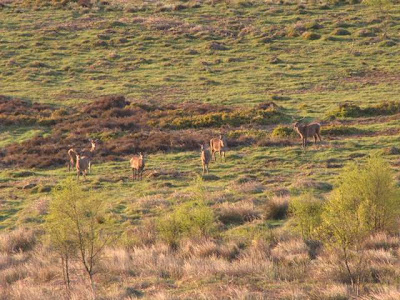Following yesterday's post about grazing policy on Blacka Moor I need to point out the relevance to current political issues, in particular the threat of cuts to public spending. We all know that an axe is about to fall and the media is full of speculation about just where. Blacka has a unique perspective on this. During all the years here when minimal management or none at all was carried out the place actually improved. Nature had its say and that cost nothing. The management approach would have been to keep it as a boring grouse moor. Nature thought different and now we have character and a dynamic change showing the seasons, song birds in the trees of the young woodland and deer roamimg the whole site. It is wild and romantic and has mystery and fascination unlike many moorland areas not far away.
SWT took over shortly after Natural England, one of our most notorious quangos, had described it as 'in unfavourable condition' (quite astonishing). This set the course for large sums of public money to be spent in defiance of what local people had asked for when surveyed in 2001 - "we like it as it is and we don't want you to change it". Most of the money went on the grazing project , bringing in livestock to 'improve' the land, which meant a major fencing and walling operation. All this was looked on with scepticism at the very least by many local people and genuine astonishment from regular users who wondered how it was possible to obtain such large quantities of public money to do a job that was not just unnecessary but something that ran counter to all that was so valuable about the site, its natural beauty and its reappeared wildlife. The increased appearance of red deer on the land, that natural grazer and browser made the decision to go in for intrusive conservation grazing even more bewildering. The truth of the matter is that the unimaginative managers and conservation professionals had mindsets hooked on preset target guidelines determined at several removes from direct experience of the character and value of these land areas. This is one reason why they refused almost in panic to countenance suggestions from us to install a site worker who would himself get to know, understand and cherish Blacka for what it is. They felt more at home in their deskjobs applying criteria which originated elsewhere but had no relevance to this bit of countryside. These were the criteria that allowed boxes to be ticked and management plans to be written which drew down grants from public funds and which kept them in their office jobs.
Public money that has been spent includes many thousands from the Heritage Lottery Fund, more from English Nature/Natural England, more from Sheffield City Council and also Single Farm Payment from the Rural Payments Agency that comes to anyone who puts farm animals on land. There is also Higher Level Stewardship another form filling and box ticking exercise.
Now the point is this. There is nothing for these people to gain from natural changes. So the beautiful wild and natural grazing animals bring absolutely no money into the coffers and actually save money for the public purse. Whereas putting farm animals on the moor costs the public but helps the conservation industry to keep going and all the jobs (mostly in offices) for people coming out of the plethora of university courses in cuddly subjects like wildlife management. So I'm in no doubt that public money going into conservation grazing projects like that here should cease completely and I would argue this even if there were no economic crisis. In the present situation I can't see how there can be any argument when so many people are struggling.
I'm someone who has always taken the side of public spending as against the huge sums accumulated by many in private employment. But this situation is one that could not be invented. In fact what I resent most of all is the way people continue with this irresponsible project seemingly oblivious to the way it fuels the prejudices of the media against public spending. It is as if they themselves have a vested interest in driving down public spending by allowing it to be so easily caricatured.

 It's on the uplands that I want to see more wild and romantic scenery. Let the trees grow and take the sheep into the lowland, they'll be much happier there. Today the hedge fringed fields are visible to the south with white blosssom. And other spaces have more random effects. All looked rather good. And when yellow appeared it was gorse, not the ghastly oil seed rape.
It's on the uplands that I want to see more wild and romantic scenery. Let the trees grow and take the sheep into the lowland, they'll be much happier there. Today the hedge fringed fields are visible to the south with white blosssom. And other spaces have more random effects. All looked rather good. And when yellow appeared it was gorse, not the ghastly oil seed rape.
































